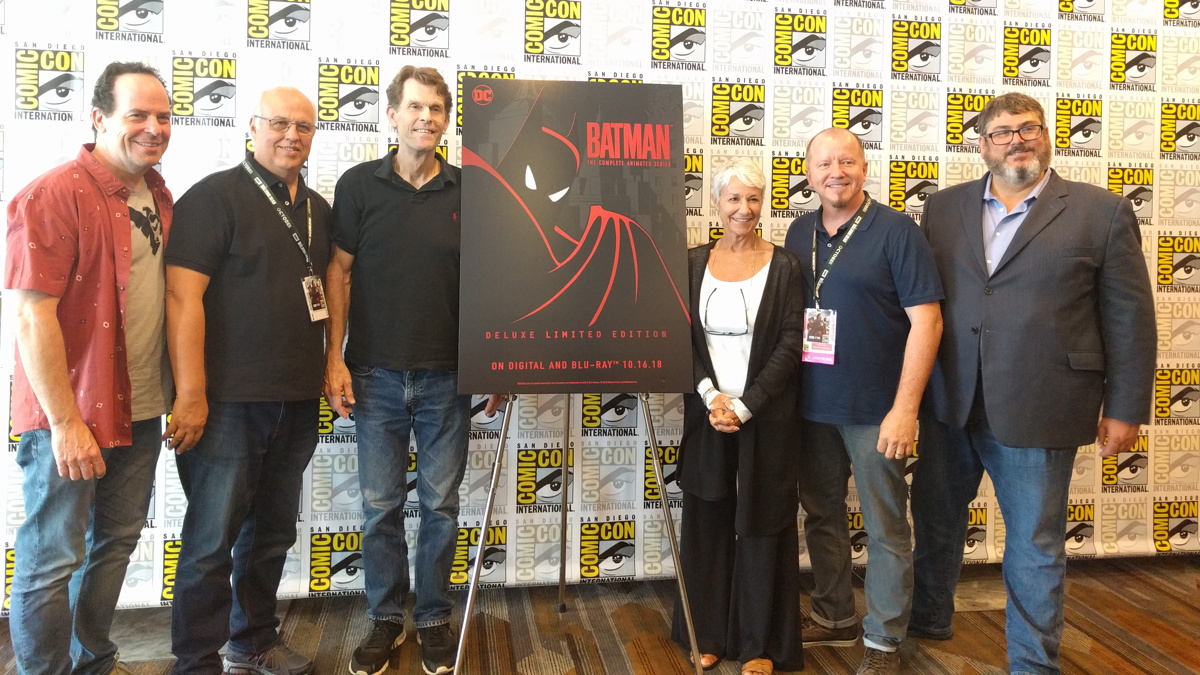To celebrate the show’s 25th anniversary and release on Blu-Ray, select cast and crew members of Batman: The Animated Series hit San Diego Comic-Con to reflect on the show’s success and promote the new collection. The Blu-Ray set, which contains all 109 episodes, Mask of the Phantasm and SubZero, also includes a newly produced, hour long documentary with various interviews.
We sat down with producers Alan Burnett and Eric Randomski, writer Paul Dini (who won an emmy for his work on the show), voice director Andrea Romano and the dynamic duo themselves, Batman (Kevin Conroy) and Robin (Loren Lester) to talk all things BTAS and why the show is still so damn popular.
A New Caped Crusader:
Kevin Conroy: Luckily, for me, I was not even aware of the Tim Burton Batman movie, which came out I think maybe a year before we did ours. I had not seen it. So I wasn’t colored by it at all. The only input I had was the Adam West show in the 60s, and when I told Bruce Timm that at the audition he said ‘no, that’s not what we’re doing.!’ He said ‘we love Adam, we love him and we love that show, but that’s not what we’re doing.’ And he brought me up to speed on the The Legend Of The Dark Knight. You know the whole legacy of Batman. So, Bruce kind of educated me. I think the fact that I was a clean slate and was just an actor approaching a role is the reason I got it. You know what I mean? Because they saw over 500 people for this role-they’ve been looking for months. But I think everyone was coming in with all these preconceived notions and anticipation and trying to do something. And I came in and just
winged it in the audition, putting myself as an actor in that situation. So, luckily, I had not seen Michael Keaton so I didn’t have any of that Tim Burton influence. After I saw it later, I thought oh this is kind of the world we’re creating -that darkness. Ours is more noir, more gritty. But it was a similar dark quality.
On the show’s longevity:
Loren Lester: “When you’re working on me on these things, no matter how good they are, and at the time we knew it was great, we knew the writing was good , we knew the story was good, the visuals, the music- everything was good. You just never know. I mean sometimes you do a wonderful movie and nobody sees it and sometimes you do a really bad film and people go ‘oh I loved that.’ So here’s something that we knew was really good but we certainly didn’t know we’d have this kind of longevity.”
Andrea Romano: Twenty-seven years ago, we were sitting there going ‘lets make this Batman cartoon,’ and we thought we’d make something really good. We did. We wanted to make something that we wanted to watch that we thought would be fun ourselves. But who could have known that twenty-seven years later, because we started two years before it released, that we’d be talking about this today. And it’s something that I’m so proud of. And what’s amazing is it’s still good. If you watch it now, it’s still a good cartoon series. It evolved. It got better. We got better. The animation got better. The voice acting got better. My casting got better. Everything improved so that we all felt like we were growing and learning. And the thing we didn’t ever want to do was repeat ourselves. We didn’t want to become stagnate. We wanted to always grow and
get a little bit darker if we could.
Is Harley Quinn the show’s biggest legacy:
Paul Dini: I think the best legacy of the show is the show itself and the fact that it keeps coming back. Now it’s to the point where it is almost like a classic, like a Disney classic movie or the Looney Tunes or something like that. And I think Harley is a wonderful bonus part of it. But, like the Looney Tunes,what’s the biggest contribution? Daffy Duck? Porky Pig? Bugs Bunny? I can’t really say, but just the fact that it’s there is great. Certainly it’s grateful to hear somebody like Jim Lee saying ‘well, the the big trio of the DC Universe is now, you know, a foursome because we’ve added Harley with Wonder Woman, Batman and Superman.
Alan Burnett: My heart belongs to the old Harley Quinn. I like that, you know, Brooklyn voice and just her nuttiness. I hope that always stays. As new versions come, they keep coming back to that first. You don’t realize how smart she.
Potential Comebacks:
Loren Lester: The one question I’m asked every single time- I do a lot of Comic-Cons all over the country- and the one question I’m asked continually is ‘why aren’t you guys doing new episodes?’ And I don’t know the answer to that because they have Kevin [Conroy], they have Mark [Hamill], they have me ,they have Tara [Strong]. They have a lot of the villains still and we all the same voices as you can hear. So, I don’t know why they don’t and I would love … if they did, we would be there in a second. I know Kevin and I have talked about it, we’d be there in a sec. Last year we did ‘Batman and Harley Quinn,’ and it was such a great reunion and it was like we had not been away from these roles for as many years as we had. So we would just fall right back into it. We love it.
Writing for Different Mediums:
Paul Dini: Well in animation you can’t write as much dialogue as you could for comic books. Sometimes, I find I have a problem with that when I’m doing a comic book. I’ll write in a very minimalist style as if I’m writing the animated series again and then I’ll go like ‘am I giving the reader enough?’ because it’s a different experience. Each experience I’ve had, in comics and then video games like with Arkham Asylum and Arkham City, have been learning processes because the rules are different. When I started writing the videogames I was writing way too much and I was writing a lot in the cut scenes and the story director would say ‘you’ve got to pace it out’ or ‘know when to cut it out.’ So the first one was a learning experience; I think I got it better with the second one. And with comics it’s the same way. It’s like you have a lot of real estate to fill up. You can go on a bit, you can have a little bit more texture, because ultimately you’re playing director as well as a writer. Whereas, in animation, you’re part of a team and the storyboard artist has his say and the director and the voiceover artist. So you’re not carrying the ball.
Being the Definitive Voice:
Loren Lester: Well I’m the first actor who ever voiced Nightwing, so no one had ever done a voice for Nightwing before, and I’m told by the people who do the Nightwing comic books and other Nightwing projects that they hear my voice in their heads when they’re doing it. So that’s a great honor. So I think I’m considered the definitive Nightwing, and it’s, you know, it’s quite a nice thing to carry around.
Kevin Conroy: Yes! The brainwashing worked! No, I get them at a very young age and I brainwash them really well so they’ll be fans for life. I’m so proud to have been a part of this. It’s such an amazing character to be a part of. He’s so resonate in the culture, you know? People love him. He’s the only superhero who has no superpowers, all he has his wits and his passion to do good. And that really resonates. So, I love being a part of the character.
Advice for Live Action:
Loren Lester: I don’t think he [Nightwing] should have a mullet. I’ll tell you what, how about if they just cast anybody and then I’ll do his voice.
Paul Dini: First off I think the tone or whatever the movie is has got to work and then Harley can work within that tone. And if it’s a funny movie, if it’s an over-the-top action comedy, if they did something like Deadpool for example and she was the chaotic element of that, I think she could work very well in something like that. If you have a very dark Batman movie, do what we would do in the animated series. We put her in there very specifically to put a laugh or make a lighter moment so that it wouldn’t be so gruesome and grim. You have to make sure that your world holds together and then you put an element like her in there.
Staying Fresh:
Kevin Conroy: I think that people can hear a lie faster than they can see it. I think you can tell when someone is lying to you by their voice pretty quickly. And the audience knows the character so well, that if I wasn’t to be true to the character, if I was to phone it in, they’d know in a heartbeat. They would nail me. So the challenge, to me over these years, in all these different venues, is to be consistent, to be fresh. And I think having been a theater actor, I’m used to doing a show eight times a week for a year. And you have to learn how to make it fresh each night. Each night the audience comes in is the first time they’ve seen it. […] So the challenge for me has been to keep him rooted. And the trick to keeping him rooted was ,for me I learned early on, that Bruce Wayne is the performance. Batman is who he is.
Would It Be Different Now:
Eric Randomski:Technology has caught up with the industry and I wish that I had the tools that I have now back then because there’s, you know, when you work on a project so closely you only see the imperfections. There are so many shows I’d love to go back into and so many things that I know are there and I can’t watch the shows the same anymore because I’m always like ‘don’t look at the scene’ because I know where all the creatures lie. So from that perspective, I think I would approach it technically differently, but as far as the tone […] we probably couldn’t make the same show today which is ironic. Twenty five years later that we got away with so much more when we made it originally than we could now because everything is so litigious. You have to be careful every step of the way: the way you portray race, color, creed and body type and language. You know, it just would have taken the life’s breath out of the series if we were trying to make it again today.
Andrea Romano: As time goes on, you’re kind of allowed to push it a little bit more. We almost never showed blood. Bruce Timm had to get special dispensation to show like a drop of blood because blood was not shown in cartoons. It just wasn’t done. And so we pushed as much as we could to get this to be… not the cartoons that I watched when I was watching Hanna-Barbera’s’ Huckleberry Hound, which I loved, adored, but we wanted to make something different.
Meeting Bob Kane:
Alan Burnett: I met [him] on the ‘Batman’ set. It was a dark set, a gritty set, and he was doing bonus material for the second Tim Burton movie. And I happened to be there, by chance, and one of the producers brought me in to meet him. He’s sitting in a Bat-throne, chair and I shook hands with him. I’m thinking ‘this is unreal! I’m in the Batcave with Bob Kane.’
Favorites:
Loren Lester: Old Wounds, Robin’s Reckoning and SubZero
Paul Dini: Heart of Ice and Almost Got Him
Alan Burnett: The Ventriloquist, Robin’s Reckoning, Feat of Clay Pt 2
Kevin Conroy: Perchance to Dream, Mask of the Phantasm (which he considers the best Batman movie ever, even including the live-action ones)









Cool interview
Comments are closed.